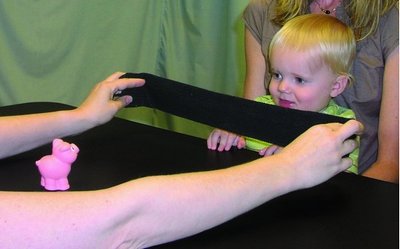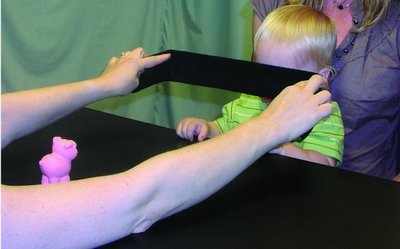September 16, 2008
Baby eyes are taking in the world, applying self-experience to other people
Those wide-eyed babies are taking in and using more information than previously believed.
In fact, new research by psychologists at the University of Washington’s Institute for Learning and Brain Sciences indicates 12- and 18-month-old babies not only are observing what is going on around them but also are using their own visual self-experience to judge what other people can and cannot see.
“This research shows how infants are using their own experiences to understand the inner lives of other people,” said Andrew Meltzoff, co-director of the UW institute and lead author of a paper appearing in the September issue of the journal Developmental Psychology.
“One of the most interesting puzzles in child development is how infants and young children come to understand other people’s emotions, thoughts and inner feelings. They can see another person’s body move, but they can’t see into another person’s heart and mind. How do babies get from observing body movements to making attributions about internal thoughts and feelings? This research indicates that a key is that they use themselves as a model for understanding others. They assume that what affects them in a certain way, also affects others in that same way. It’s a good bet, and it works,” added Meltzoff, who holds the Job and Gertrud Tamaki endowed chair.
In the research, Meltzoff and co-author Rechele Brooks, a UW research scientist, used a behavior called gaze following. It refers to a baby (or an adult) looking where another person has just looked. Psychologists have known for some time that detecting the direction of another person’s glance is an important component of human social interactions. Gaze following also boosts an infant’s early vocabulary growth and emotional understanding.
“You can learn a lot by watching other people,” said Brooks. “Gaze following also provides a social way of learning about the world and that what other people are interested in matters.”
To test the idea that babies are using their self-experience to judge what people can see, the UW researchers devised a pair of experiments using ordinary and specially made blindfolds.
In the first experiment, 96 1-year-olds (half boys and half girls) played with a piece of black cloth that was placed under a series of toys in front of them on a table. One third of the infants were randomly put in a group that received no more play time. The other babies were divided into two other groups that received special play time with the cloth. One group played a game in which a researcher held a black blindfold in front of the children’s eyes, blocking their view of interesting toys on the table. The other group played the same game, only the blindfold held in front of them had a large hole cut in it like a window so they could see the toys.
Finally the researcher put on a blindfold and turned toward a toy either to the left or right. The babies who only had played with the cloth flat on the table and those who had been exposed to the blindfold with thewindow in it followed the gaze of the researcher as though she could see the toy. The babies who were exposed to the real blindfold experience, however, spent little time following the gaze of the researcher, presumably thinking the blindfolded person could not see just as they could not see when the blindfold blocked their view of the toys
During these games, children learned that “an opaque cloth blocks their own perception and they immediately generalized this to others, a very early form of role-taking,” said Meltzoff. “This illustrates that infants treat others as ‘like me’.”
In the second experiment, 72 18-month-olds (again equal numbers of boys and girls) played with a black cloth. Next the babies were randomly assigned to two groups, one that played with a regular blindfold and the other with a trick blindfold that had a special see-through mesh sewn into it that allowed them to see a toy when it was held up to their eyes. Only babies who played with the see-through blindfold followed the gaze of the researcher when she put on the blindfold and turned toward a toy.
“If they can see through the blindfold, they assume the other person can see through it as well,” said Brooks. “In both experiments the only difference is what the children experienced in training. It appears babies are taking in information and applying it to others.”
The UW researchers believe this work is important because it uncovers a crucial mechanism that babies use to understand the social-emotional lives of others.
“The babies are using their own self-experience to interpret the behavior of others. They are making a bet: You are ‘like me’ and so my own experiences apply to you. By learning about themselves, they are coming to understand us. This is a fundamental life-lesson and one that begins well before they enter kindergarten,” said Meltzoff
The research was funded by the National Institute of Child Health and Human Development, the National Science Foundation, and the Tamaki Foundation.
###
For more information, contact Meltzoff at (206) 685-2045 or meltzoff@u.washington.edu or Brooks at (206) 685-2045 or recheleb@u.washington.edu.


